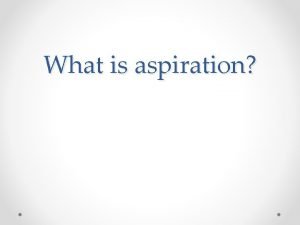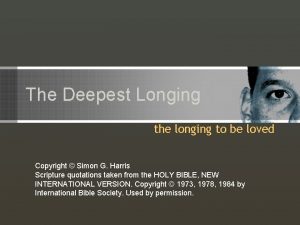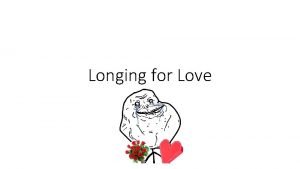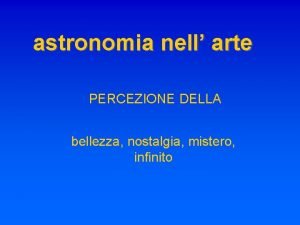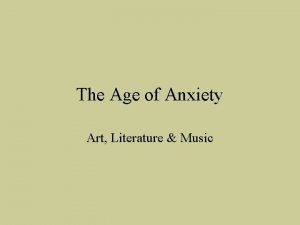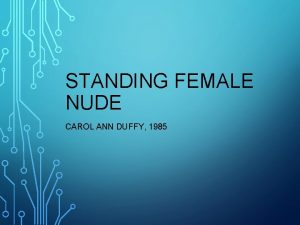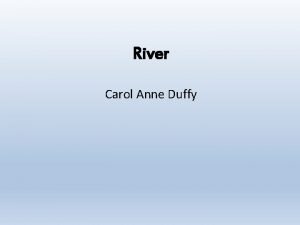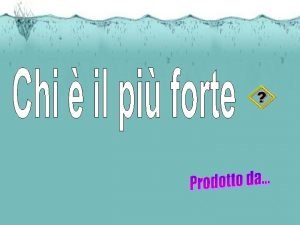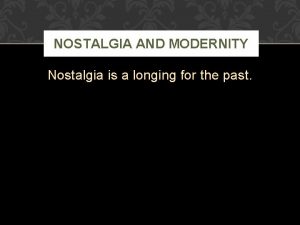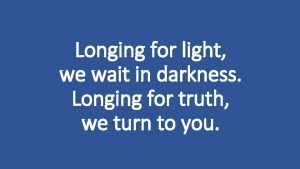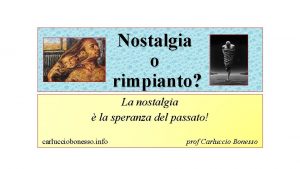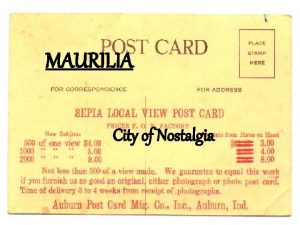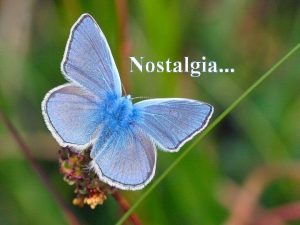Nostalgia Nostalgia refers to a longing for a










- Slides: 10

Nostalgia • Nostalgia refers to a longing for a past that has been idealized. • Many critics point to the prevalence of nostalgia in children’s written during the “Golden Era, ” from 1865 -1930. For authors such as Carroll, J. M. Barrie, Kenneth Grahame, and A. A. Milne, the desire to escape the adult world and reside in the seeming “safety” of childhood comes through in their creation of elaborate fantasy lands in which the adult world is either mocked or seemingly forgotten. • Hemmings puts forward the idea that the seemingly nostalgic mentions of food in Alice’s Adventures in Wonderland all turn into something less than golden. Let’s see how he constructs his argument….

Nostalgia

Nostalgia • Re-read the poem at the beginning of Alice’s Adventures in Wonderland. • What adjectives does Carroll use to describe the day? • What adjectives does Carroll use to describe the children? • How might this poem be seen as an example of nostalgia?

“Solitude” • When he was twenty-one years old, Carroll wrote this poem: Ye golden hours of Life's young spring, Of innocence, of love and truth! Bright, beyond all imagining, Thou fairy-dream of youth! I'd give all wealth that years have piled, The slow result of Life's decay, To be once more a little child For one bright summer-day. • Note how this poem parallels much of the language found in the opening poem to Alice’s Adventures in Wonderland, suggesting that Carroll had pondered a return to childhood from the moment he was considered to be an adult.

Hemmings on the Threats to Nostalgia • Think of as many examples as you can of the appearance of food in the text – what goes on when food appears? • Hemmings draws “attention to the particularities of these tastes (and their attendant smells) and suggest[s] that they are rich with associations of a privileged middle-class Victorian childhood, both Alice Liddell's and Charles Dodgson's: exotic fruit, desserts, a roast dripping with holiday associations, comforting toast, candy, nary a vegetable to wrinkle a child's nose. ” • However, Hemmings notes that each “pleasing act of consumption produces terrifying consequences. ”

Threats to Nostalgia • Hemmings: “My point is that the act of tasting, of consuming food in the lost world of childhood recreated through nostalgia, like the act of tasting in Eden, reveals the fault lines that threaten the stability of the nostalgic vision. ” • “…the obsessive focus on bizarre dining partners and strange acts of consumption transmitted through this very same impulse reveals an underlying repressed desire that produces the disharmony, tension, and anxiety with which eating in this vision is freighted. ”

Nostalgia • Look at the last few paragraphs of the text – how do they fit in to Hemmings’ argument about nostalgia?

What is Wonderland? • Write down as quickly as possible all of the characteristics that you can think of related to the Wonderland created by Lewis Carroll. • How would you charcterize Alice’s interactions with the people and creatures of Wonderland? • Let’s look at how another critic considers these issues: Jennifer Geer. “"All sorts of pitfalls and surprises": Competing Views of Idealized Girlhood in Lewis Carroll's Alice Books. ” Children’s Literature 31 (2003): 1 -21.

Geer’s Take on the Story’s Frames • “Although the frames do imply that the tale will help Alice grow into a woman who retains the best characteristics of her childhood, the contrast between frames and adventures indicates that the original dream-tale must be edited in order to produce this developmental narrative. ” • “The frames, which introduce another level of adult mediation by including the sister and the prefatory poem's speaker, shift the center of attention away from Alice, concentrating instead on adults' reactions to her and her tale. The disjunction between the frames' placid visions and Alice's anger, frustration, and bewilderment in Wonderland calls attention to the differences between Alice's experiences and the desires of adult figures. ”

Geer • “The frames may emphasize play and reciprocity, but they rest on adult power and self-interest. It is no accident that Alice's sister sends the girl in to tea before beginning her own reveries. Neither the sister nor the prefatory poem's speaker has any interest in understanding the more disturbing or rebellious aspects of Alice's adventures. On the contrary, the sister's musings emphasize the delights of this ‘strange tale’ (164). Similarly, in keeping with the conventional stress on cheerful tales and innocently charming girls, Alice's generally uncomfortable and even hostile interactions with the Wonderland creatures become ‘friendly chat[s]’ in the prefatory poem (23)”.

